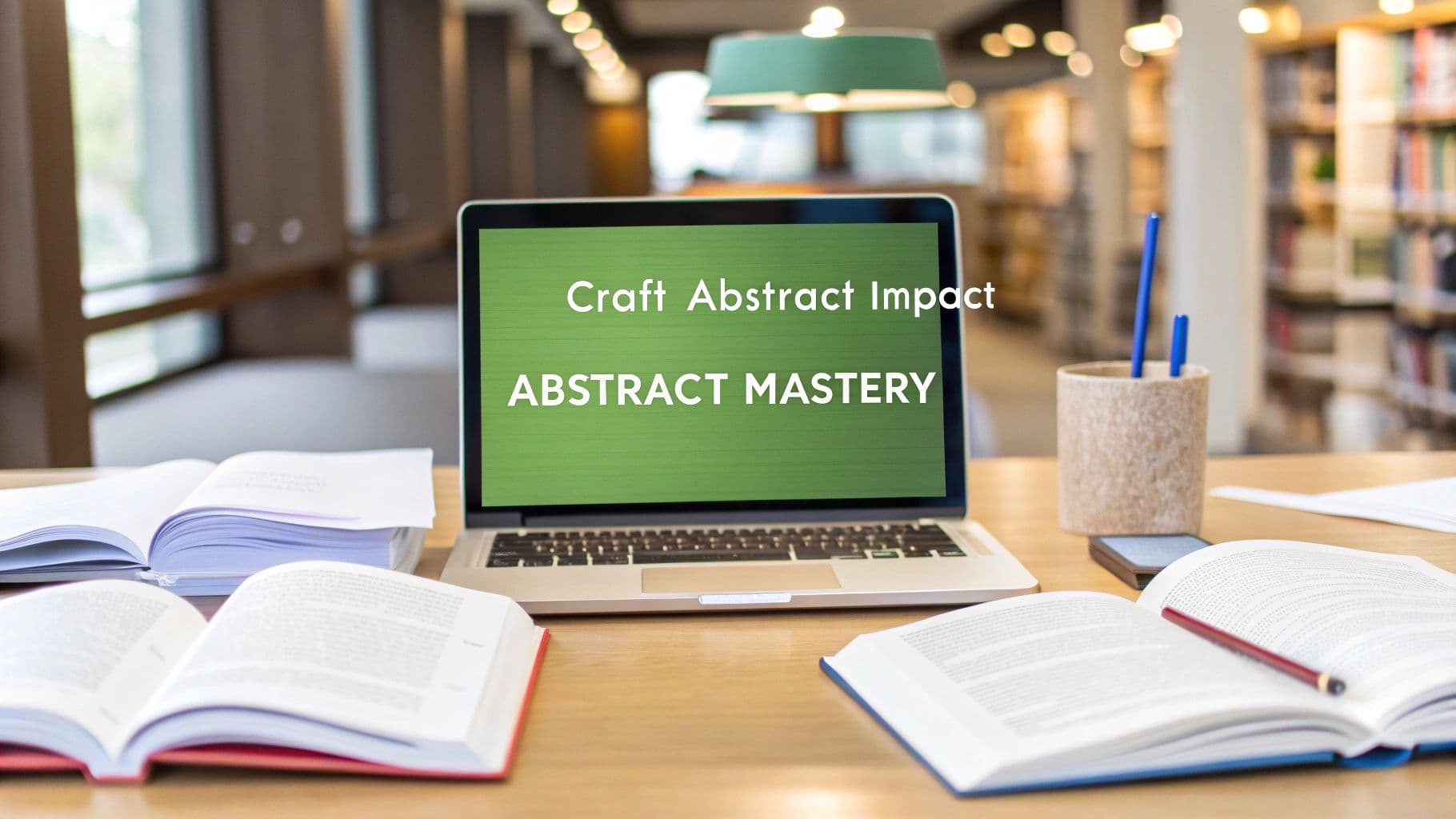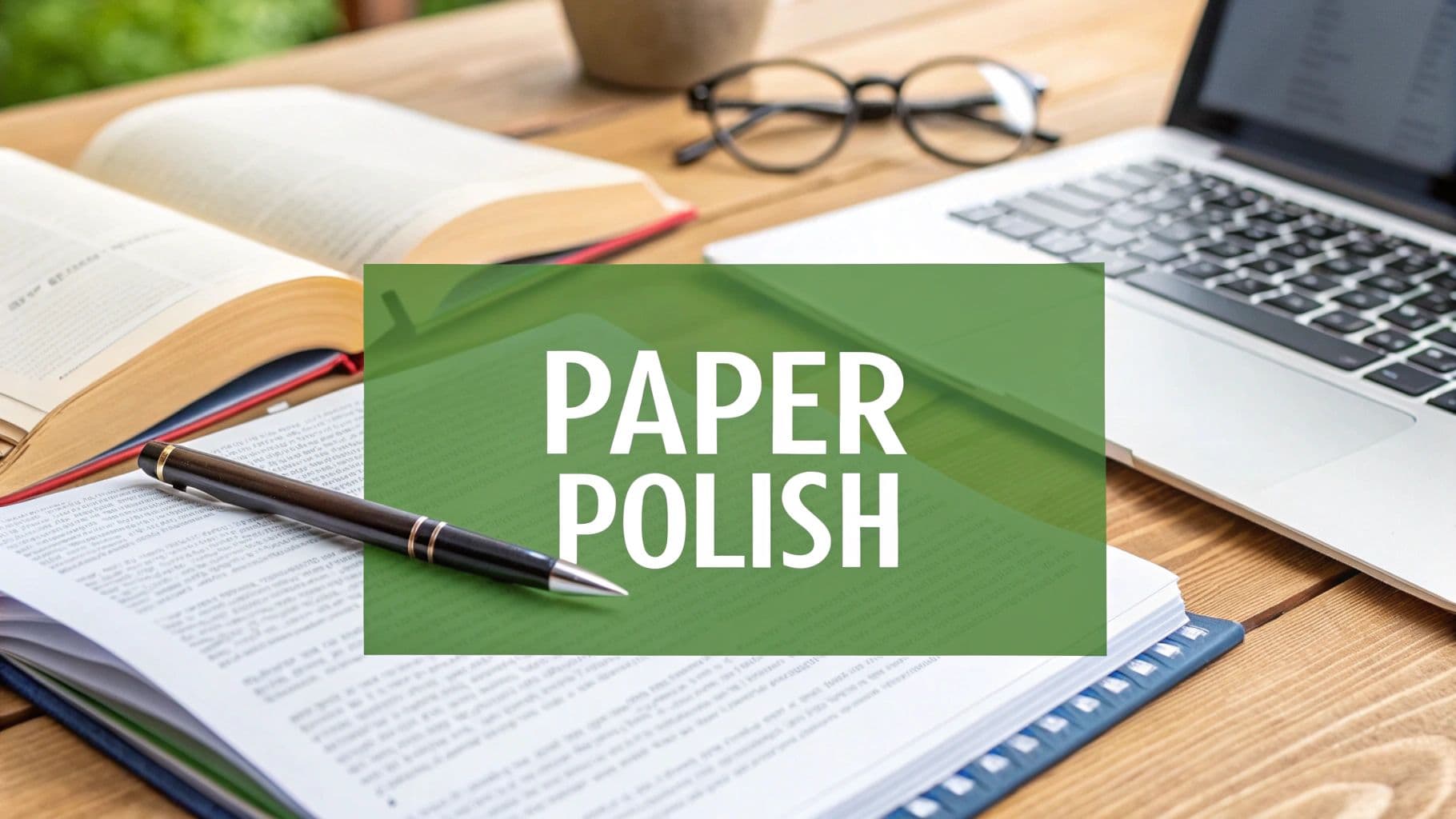
How to Edit a Research Paper: Expert Tips for Success
June 27, 2025
When you sit down to edit your research paper, it’s tempting to try and fix everything at once. You spot a typo, then question a paragraph's flow, then get sidetracked by a citation. This chaotic approach is exhausting, and worse, it’s ineffective.
Instead of a single, frantic pass, think of editing as a series of focused stages. It’s a more strategic way to work, turning a mountain of a task into a manageable process.
Your Strategic Roadmap for Editing a Research Paper
The real secret to a great edit is separating the big-picture problems from the small ones. You wouldn’t polish the windows on a house before making sure the foundation is solid, right? The same logic applies here.
First, you tackle the structure and argument. Only after that’s locked in do you move on to refining sentences and, finally, hunting down typos.
Breaking Down the Editing Process
This three-stage process shows you how to move from broad structural assessments to the tiniest details.
The flow is clear: start with the blueprint (structure), then build out the content (revision), and finish with the final polish (proofreading). This sequence saves you from wasting hours perfecting sentences in a section that you might end up deleting anyway. For a deeper look at getting that initial structure right, our guide on crafting a strong research paper outline is a great place to start.
The Value of a Polished Paper
This disciplined approach to editing has never been more critical. The demand for high-quality, clear communication is surging everywhere. In fact, the global market for editing and proofreading services was valued at around USD 0.77 billion and is expected to more than double by 2033. You can explore more on this trend and what it means for publishing and academia.
What does that number tell us? That a polished, meticulously edited paper dramatically boosts your credibility and the impact of your work.
Key Takeaway: The point isn't just to find mistakes. It's to systematically strengthen your paper at every level—from its core argument down to the last comma. Separating your tasks is the most effective way to edit a research paper without getting overwhelmed.
When you work this way, you stay in control. You can use modern tools as an assistant, not a replacement, ensuring your expertise guides every decision. This method doesn't just create a better paper; it makes you a better writer.
The Structural Edit: Strengthening Your Paper’s Foundation
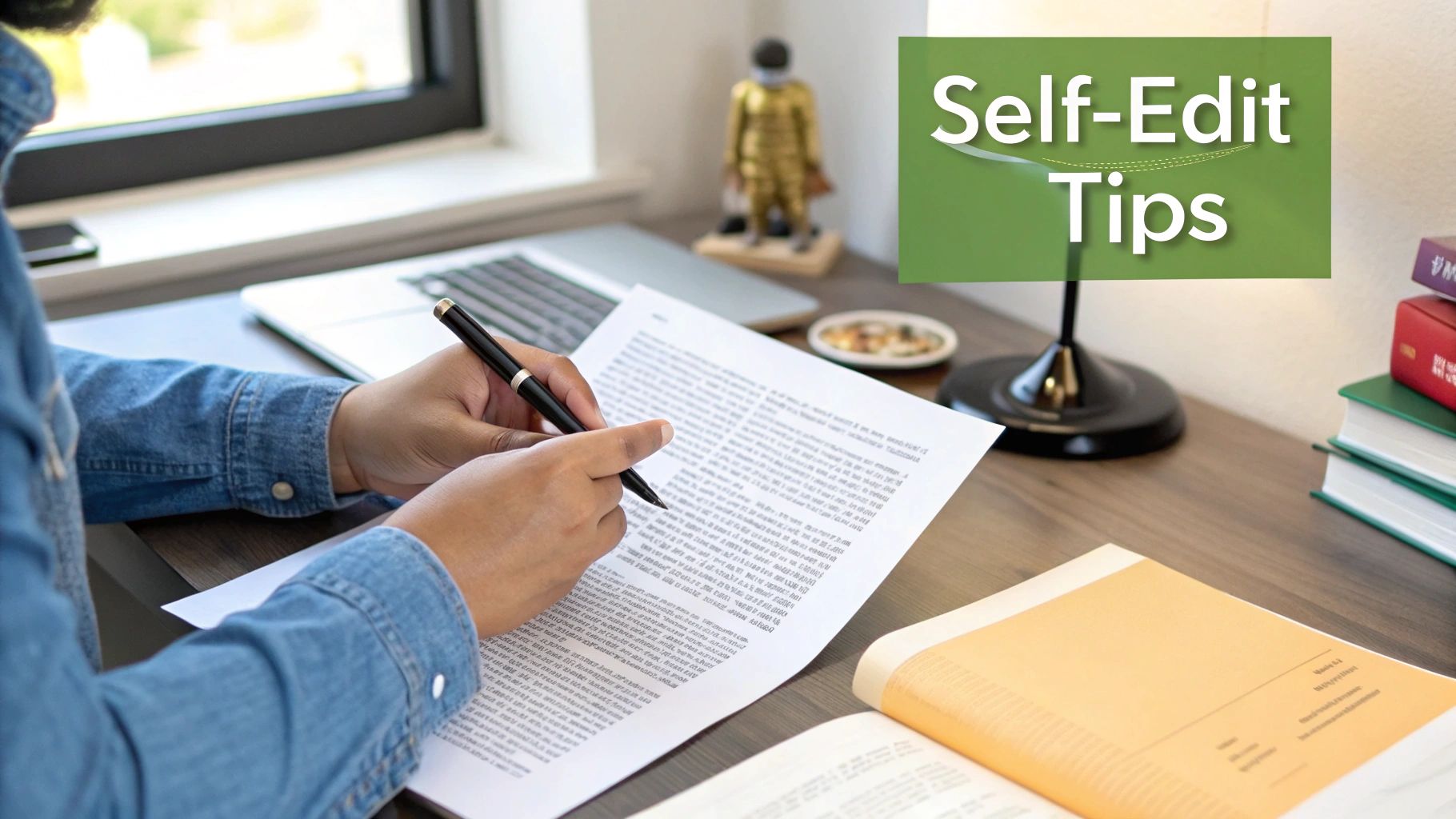
Before you even think about commas or sentence structure, you need to look at the big picture. Your first editing pass should be all about the architecture of your research—the structural edit.
Forget the small stuff for now. This is where you test the strength of your paper's foundation. Think of yourself as a building inspector. Is your thesis solid? Do your main arguments connect logically, or are there cracks a reviewer could easily exploit? This stage is all about asking the hard questions to see if your paper stands strong or crumbles under pressure.
Evaluating Your Core Argument
The heart of your paper is its central argument, the thesis. Every single thing you've written exists only to support it.
Start by isolating that thesis statement and asking yourself a brutally honest question: Does my evidence actually prove this?
It’s surprisingly common to realize your research journey led you to a slightly different conclusion than the one you started with. That's a normal part of discovery! But during the edit, you have to fix that disconnect.
- Try reverse outlining. Go through your paper, paragraph by paragraph, and jot down the main point of each one. Then, read only those points. Do they create a coherent story that builds toward your conclusion? This trick instantly reveals logical gaps or sections that are out of order.
- Do a thesis-evidence check. Make a simple two-column list. In one column, write your thesis. In the other, list every key piece of evidence from your results. This gives you a visual map of what supports your argument versus what might be irrelevant or, worse, contradictory.
If you find a mismatch, you’ve got two options: rewrite your thesis to reflect what your evidence actually shows, or find more evidence to back up your original claim. Be honest with yourself. A powerful paper has perfect alignment between its claims and its proof.
A structural edit isn't about fixing sentences; it's about fixing the story your research tells. Make sure the promise you make in your introduction is the one you actually keep.
Assessing Logical Flow and Cohesion
Once you're confident in your core argument, zoom out and look at the flow. A reader should move smoothly from your introduction to your conclusion without ever feeling lost.
Does your introduction set the stage properly? Does the literature review logically lead to the research gap you’re trying to fill? And, most importantly, does your conclusion actually summarize your findings, or does it veer off and introduce new ideas? Each section should feel like the natural next step.
Here’s a simple checklist to run through as you review the paper's overall structure. Think of it as your high-level guide to make sure the foundational pieces are compelling and hang together.
Core Elements for Your Structural Edit
| Component | What to Check For | If It's Weak |
|---|---|---|
| Introduction | Is the thesis clear, specific, and arguable? Does it hook the reader? | Your paper lacks a clear purpose from the start. |
| Body Paragraphs | Does each paragraph have one main focus? Do topic sentences guide the reader? | Arguments feel jumbled and hard to follow. |
| Evidence | Is evidence presented logically and tied directly back to the main argument? | The "so what?" question is never answered. |
| Transitions | Are the connections between sections and paragraphs smooth and logical? | The paper feels choppy and disconnected. |
| Conclusion | Does it powerfully summarize the research without introducing new information? | The paper ends abruptly or loses its impact. |
A quick review using this table can save you from major headaches down the line. It ensures the intellectual core of your work is solid.
This process also forces you to refine your academic voice. To keep your writing clear and professional, check out our detailed academic writing style guide. It’s a great resource for maintaining a consistent tone.
Ultimately, a thorough structural edit is the most important part of the process. Without a strong foundation, no amount of sentence-level polishing can save a weak argument. By dedicating a full pass to these foundational issues first, you set your paper up for success.
The Line Edit: Refining Clarity and Academic Voice
With your paper's structure locked in, it’s time to zoom in from the blueprint to the bricks and mortar. This is the line edit, where you meticulously examine your writing sentence by sentence. The goal is to make every word count, ensuring your prose is not just grammatically correct but also sharp, clear, and persuasive.
This stage moves beyond a simple spell-check. It’s about shaping your academic voice so it sounds confident, professional, and authoritative. You’ll be hunting for the common writing pitfalls that can make brilliant research feel dense and unapproachable.
Trim Wordiness and Ditch the Jargon
Academic writing has a reputation for being overly complex. We sometimes fall into the trap of using complicated words and long-winded phrases, thinking it makes us sound more scholarly. It usually just confuses the reader.
Your first mission is to find and destroy filler phrases. These are the words that add length but zero meaning. For example, "due to the fact that" is a clunky way of saying "because."
Keep an eye out for these common culprits:
- "In order to" can almost always be shortened to "to"
- "It is important to note that" is a classic—you can often delete it entirely
- "For all intents and purposes" is usually just fluff
- "A large number of" can be simplified to "many"
Next up is jargon. While some technical terms are essential in your field, others are just buzzwords that shut out anyone who isn't a specialist. For every piece of jargon, ask yourself: Is there a simpler way to say this without losing precision? If the answer is yes, make the change. Your work will be far more impactful for it.
Pro Tip: Read your paper out loud. I’m serious. Your tongue will trip over awkward phrasing and convoluted sentences that your eyes might miss. This simple trick is one of the most effective ways to find sections that need smoothing out.
Strengthen Sentences with Active Voice
Want to inject instant energy and clarity into your writing? Switch from passive to active voice. Active voice is direct and confident; passive voice can feel weak, evasive, and frankly, a bit dry.
It’s a simple change with a big impact:
| Passive Voice (Weak and Indirect) | Active Voice (Strong and Direct) |
|---|---|
| The experiment was conducted by the research team. | The research team conducted the experiment. |
| It was found that the results were inconclusive. | We found that the results were inconclusive. |
| The samples were analyzed using mass spectrometry. | We analyzed the samples using mass spectrometry. |
Notice how the active voice sentences are often shorter and always clearer about who is doing the action. It's a more assertive way to present your work. While passive voice has its place—like when the action itself is more important than who did it—overusing it will drain the life from your paper.
Do a quick search for passive constructions like "was done," "is seen," and "were analyzed." For each one, see if you can rewrite it in the active voice. Most of the time, you can, and your sentence will be stronger for it.
Give Each Paragraph a Single, Clear Focus
Just as every sentence needs a purpose, every paragraph needs a single, unified point. When a paragraph tries to cover too much ground, it becomes a mess. The reader gets lost, and your argument loses its punch.
As you line edit, check that each paragraph follows a simple structure:
- Topic Sentence: The first sentence should introduce the paragraph's main idea. No surprises.
- Supporting Sentences: Everything that follows must provide evidence, examples, or explanation to back up that main idea.
- Concluding/Transitional Sentence: The last sentence should wrap things up or create a smooth bridge to whatever comes next.
If you spot a paragraph juggling multiple ideas, just split it. Giving each distinct point its own space improves the logical flow and makes your argument much easier to follow. This is how you sharpen not just your sentences, but the micro-structure of your entire paper.
The Final Proofread: Catching Every Last Error
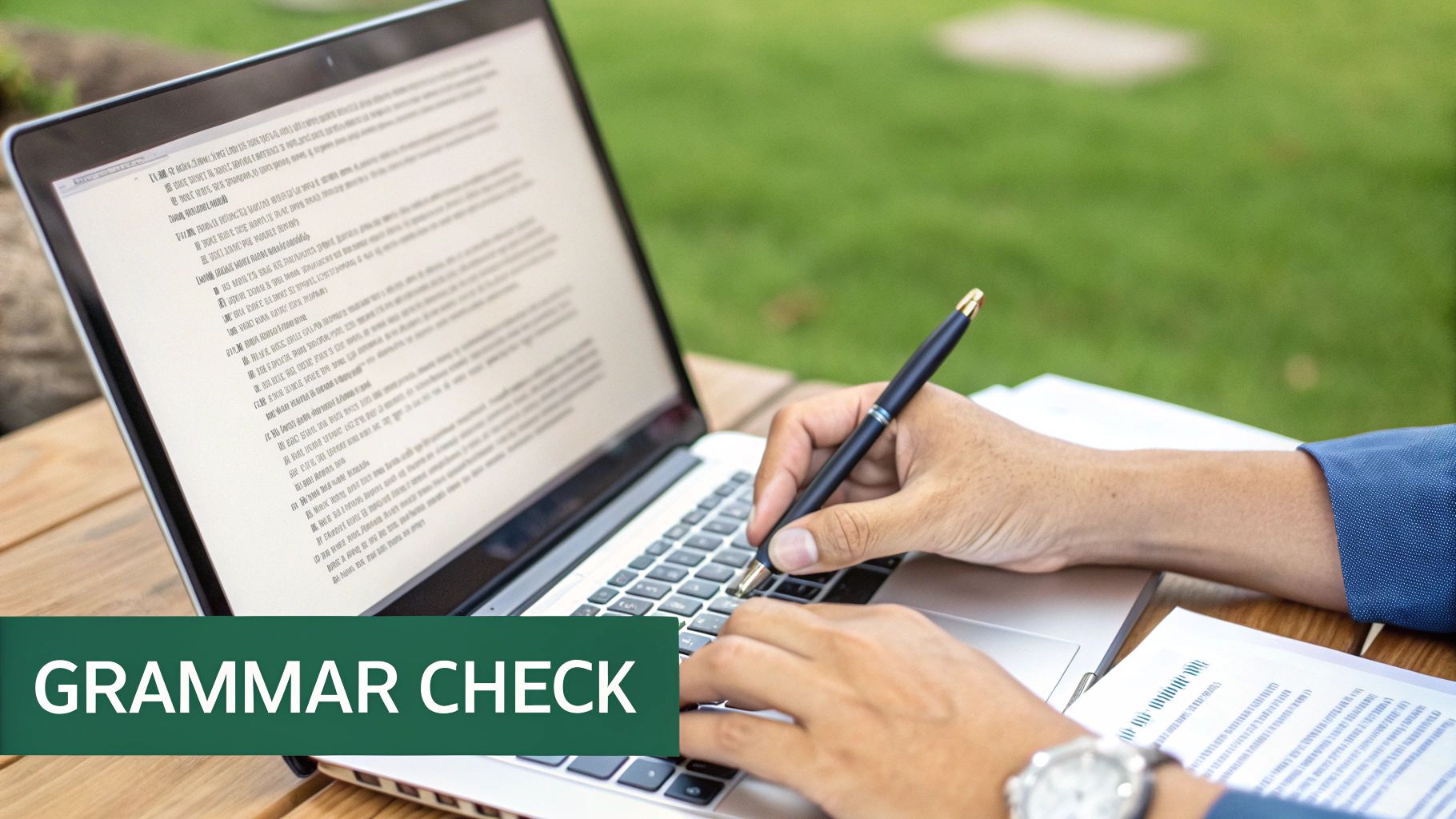
This is your final line of defense. You've wrestled with the structure, refined your arguments, and polished your sentences. Now it’s time for the meticulous hunt for those tiny, lingering errors.
Proofreading isn't the same as editing. It's a completely different mindset. Think of it as the final quality control check that happens only after all other revisions are done and dusted. Its sole purpose is to catch the small but costly mistakes that can tank your credibility. A single typo in your abstract or a misplaced comma can be enough to distract a reviewer and make them question your attention to detail.
The hardest part? Your brain already knows the text too well. You know what you meant to write, so your mind will often autocorrect mistakes as you read. To do this right, you have to trick yourself into seeing what’s actually on the page, not what you think is there.
Force Yourself to See the Paper Differently
The secret to a good proofread is to break your routine. You need to disrupt how you normally engage with your document so the errors jump out at you.
One of the best tricks in the book is to change the medium. If you wrote the entire paper on a screen, print it out. Holding a physical copy and running a pen over the words forces a different kind of focus. You’d be surprised what your eyes catch on paper that they glide right over on a monitor.
Another fantastic technique is to read your paper aloud. Your ears will catch what your eyes miss—awkward phrasing, missing words, and clumsy sentences. It forces you to slow down and process every single word.
The point of these techniques isn’t just to find mistakes. It’s to force your brain out of its comfort zone. When the text feels unfamiliar, the errors have nowhere to hide. This is a crucial step when learning how to edit a research paper effectively.
Your Final Proofreading Checklist
As you do this last pass, don't try to catch everything at once. That's a recipe for exhaustion and missed errors. Instead, do a few quick, focused read-throughs, each time looking for a specific type of mistake.
1. Typos and Spelling Gaffes These are the most common—and most embarrassing—errors. Go beyond what a spell-checker finds and look for sneaky typos like "form" instead of "from" or "then" instead of "than."
2. Punctuation and Grammar Gremlins This is where you hunt for specific issues that can muddy your meaning.
- Comma Splices: Two full sentences incorrectly joined by just a comma.
- Apostrophe Abuse: Confusing "its" (possessive) with "it's" (it is).
- Subject-Verb Agreement: Make sure your subjects and verbs match, especially in those long, complex sentences.
3. Formatting and Consistency A lack of consistency just looks sloppy. Run a final check on these details:
- Citations: Are all in-text citations and your bibliography formatted correctly (APA, MLA, Chicago, etc.)? Are any references missing?
- Headings: Is the capitalization and style of your H1, H2, and H3 headings the same throughout the document?
- Figures and Tables: Does every figure and table have a correctly formatted label? And, crucially, does your reference in the text (like "see Figure 3") actually match the label?
This final, careful polish is what separates a good paper from a great one. It ensures all your hard work is presented with the professionalism it deserves, leaving no room for a reviewer to get sidetracked by preventable slip-ups.
Using Editing Technology the Smart Way
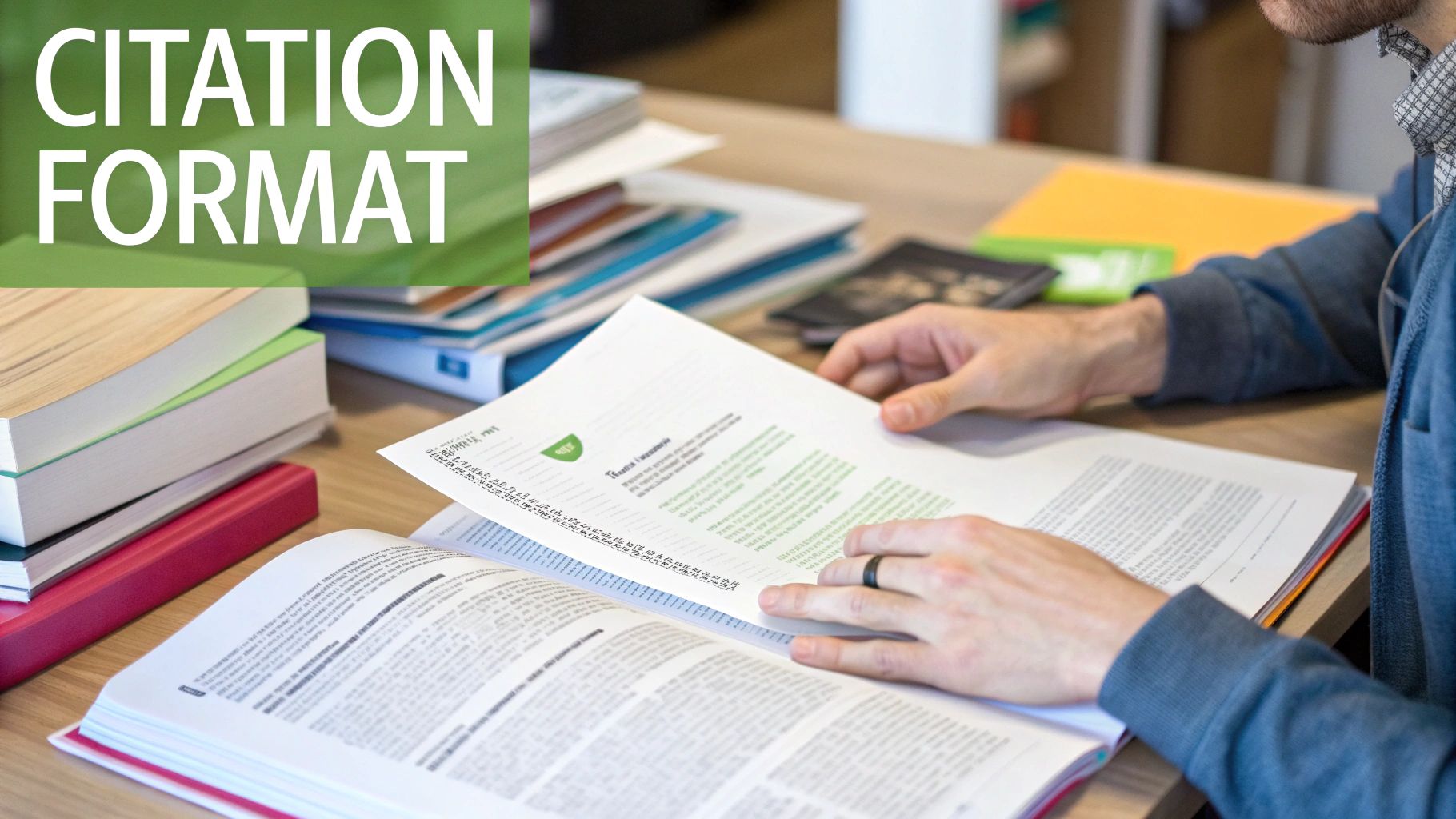
Editing tools can be a researcher's best friend. But like any powerful tool, you have to use them smartly. They can be a fantastic assistant or a damaging liability, and the difference comes down to your approach.
The secret is to let technology handle the tedious, mechanical work. This frees up your brainpower for the kind of critical thinking that no algorithm can ever replicate. Think of these tools as a first line of defense, catching the obvious stuff so you can focus on what really matters.
Setting Expectations for Your Digital Tools
Modern editing software is incredible at spotting objective errors. A tool like Grammarly will flag typos, subject-verb agreement issues, and rogue commas with impressive accuracy. That alone saves hours of painstaking proofreading.
But it’s just as important to know what they can't do. A grammar checker can tell you if a sentence is grammatically sound, but it has no idea if your core argument is weak. It might flag passive voice, but it can't tell you if your tone is appropriate for your target journal. These tools lack context. They don’t understand nuance or the overarching story you’re trying to tell.
Key Insight: Technology is your co-pilot, not the pilot. It scans the instruments and reports anomalies, but you're the one flying the plane. Rely on it for support, but never surrender your own critical judgment.
That distinction is everything. This hybrid approach—letting tech find the easy mistakes so you can focus on the hard ones—is simply the most efficient way to edit.
A Smart Workflow for Using Editing Tech
To get the most out of your tools, you need a structured workflow. Don't just run a single grammar check at the end and call it a day. Instead, layer the tools into your editing process at the right moments.
Here’s a sequence that works well:
- Reference Managers (Zotero, EndNote): Use these from the very beginning. Seriously. They keep your citations consistent and correctly formatted, preventing a massive headache during the final proofread.
- Plagiarism Detectors (Turnitin): Run your draft through a plagiarism checker before you start your final line edits. This gives you a chance to fix any accidental overlaps or weak paraphrasing while you're still in that revision mindset.
- Grammar and Style Checkers: Save these for last—after you’ve finalized your structure and arguments. Using them too early means you’ll just waste time polishing sentences in a section you might end up deleting anyway.
This deliberate sequencing makes sure you’re using the right tool at the right time.
The Bigger Picture on Precision Editing
This drive for precision isn't just about writing. Look across other scientific fields, and you’ll see the demand for sophisticated editing techniques growing everywhere.
The gene editing market, for example, is projected to rocket from USD 3.41 billion to USD 13.36 billion by 2035. This isn’t just a niche trend; it shows a broader movement toward extreme accuracy in all modern research. You can explore more about the expanding need for precision in biotechnology to see just how deep this goes.
While the methods are different, the principle is the same. Whether you’re editing a gene sequence or a research paper, the quality of your work hinges on precision and careful, expert review. Blindly trusting an automated tool for either task would be a critical mistake. Your expertise must always be the final authority, guiding the technology to produce a polished, credible, and truly impactful result.
Common Research Paper Editing Questions Answered
Even with a solid editing strategy, you're bound to run into a few snags. We all do. Navigating those last-minute questions and dilemmas is just part of the process.
Let's tackle some of the most common questions researchers have when they finally sit down to polish their work. These are the real-world challenges that pop up after the heavy lifting of writing is done, and the answers can help you make smart, efficient decisions in the home stretch.
How Much Time Should I Wait Before Editing My Paper?
Give yourself as much distance as you can possibly afford. A minimum of 24 to 48 hours is a good starting point, but a full week is even better if your deadline allows it.
This isn't about procrastination; it's a strategic move. When you're deep in the writing zone, your brain gets really good at filling in logical gaps and auto-correcting small mistakes as you read. You end up seeing what you meant to write, not what’s actually on the page.
Stepping away for a few days breaks that mental connection. When you come back, you’re looking at it with "fresh eyes," making you far more likely to catch everything from major structural flaws to tiny typos you were completely blind to before. Think of this cooling-off period as a non-negotiable part of a good self-edit.
What Is the Biggest Mistake Researchers Make When Editing?
Hands down, the single biggest mistake is trying to edit for everything at once. It's incredibly tempting to try and fix the argument, sharpen sentences, correct grammar, and check citations all in one go. But it's a recipe for disaster.
Your brain simply can't juggle that many different tasks effectively. This "all-in-one" approach leads to mental burnout, sloppy work, and a much higher chance that you'll miss significant errors. It's the main reason so many self-edits just aren't as thorough as they could be.
The fix is the multi-pass system we’ve been talking about. Dedicate separate, focused reads for each big task—one for structure, another for line editing, and a final one for proofreading. This method feels much more systematic, is way less overwhelming, and is dramatically more effective.
When Should I Consider a Professional Editing Service?
This really comes down to what’s at stake. For a doctoral dissertation, a major grant proposal, or a submission to a top-tier journal, hiring a professional editor can be a game-changing investment.
An expert editor brings an objective perspective that you simply can't replicate on your own, especially after you've spent months staring at the same words. This is particularly true for researchers who are non-native English speakers.
When should you do it yourself?
- For a standard course paper or an internal report, the self-editing techniques in this guide are usually more than enough.
- If you’re on a tight budget, pouring that extra time and focus into the multi-pass method can get you pretty close to professional-level results.
If you do go the professional route, vet them carefully. Always look for an editor with proven experience in your specific academic field. You need someone who already knows the conventions and terminology. For more general advice, you can also explore some overarching guidelines for writing a research paper to make sure you’ve covered all your bases.
What Is a Practical Trick for Making My Writing More Concise?
One of the quickest ways to tighten up your writing is to go on a "filler phrase" hunt. This means actively searching for and cutting wordy, empty phrases that add length but absolutely no value.
For example, you can almost always change "due to the fact that" to a simple "because." "In order to" can be shortened to just "to." And phrases like "it is important to note that" can often be deleted entirely with zero loss of meaning.
Another great tactic is to find sentences clogged with prepositions. Chains of words like "of," "in," "on," and "for" often signal a clunky sentence that can be rephrased for more punch.
Example of Cutting Wordiness
| Original (Wordy and Weak) | Revision (Concise and Strong) |
|---|---|
| The findings of the study provide an indication of the effects of the treatment. | The findings indicate the treatment’s effects. |
| It is evident that further research will be required in the future. | Further research is required. |
Making these small tweaks consistently will make your writing stronger, clearer, and much more direct.
After meticulously editing your paper, you might find that some AI-generated sentences still sound robotic or lack flow. Natural Write can help with that final polish. Our free platform transforms AI text into natural, human-like language, ensuring your writing is clear, readable, and ready for submission. Refine your draft with confidence at https://naturalwrite.com.
